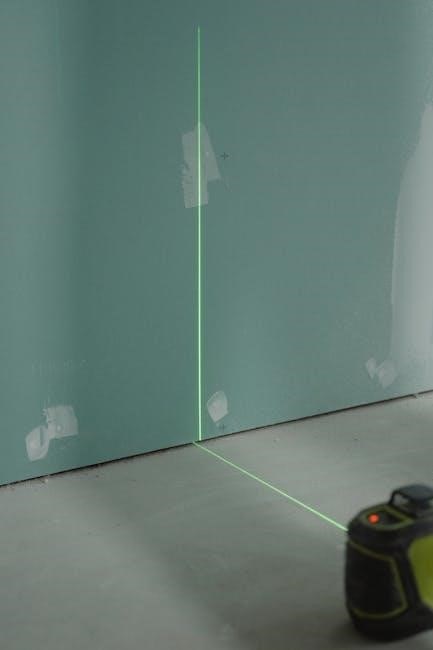The Telecaster, Fender’s iconic guitar, revolutionized music with its twangy tone and simple design․ This guide explores its wiring, from classic setups to modern modifications, helping you unlock its full sonic potential․
1․1 Overview of the Telecaster Guitar
The Fender Telecaster, introduced in 1950, is one of the most influential electric guitars in music history․ Known for its bold, twangy tone and durable design, it was the first commercially successful solid-body guitar․ Originally called the Esquire, it evolved into the Broadcaster before settling on the Telecaster name․ Its simplicity, with two single-coil pickups, a 3-way switch, and basic controls, has made it a favorite among players across genres․ The Telecaster’s versatility and timeless design continue to shape music today․
1;2 Importance of Proper Wiring
Proper wiring is essential for optimal Telecaster performance, ensuring clear tone and reliable functionality․ Incorrect wiring can lead to electrical issues, hum, and tonal loss․ Accurate connections preserve the guitar’s intended voice, allowing players to achieve desired sounds․ Proper wiring also enables smooth operation of pickups, switches, and controls, maintaining the guitar’s responsiveness․ For modding, correct wiring is crucial to avoid damage and ensure new components integrate seamlessly․ It guarantees longevity and maintains the guitar’s playability and sonic integrity․
1․3 Brief History of Telecaster Wiring
The Telecaster’s wiring traces back to its 1950 debut as Fender’s first mass-produced guitar․ Evolving from the Esquire, it introduced a two-pickup design; Initially featuring a straightforward circuit with a 3-way switch, master volume, and tone control, the wiring aimed for simplicity and functionality․ Over the years, slight modifications emerged, but the core design remained consistent․ The original wiring layout set a precedent, influencing future guitar designs and maintaining the Telecaster’s signature sound․ Its enduring circuitry reflects its timeless design philosophy․

Standard Telecaster Wiring
The standard Telecaster wiring features a 3-way switch, master volume, and tone control, providing a simple yet versatile circuit for classic tones and straightforward functionality․
2․1 Basic Wiring Diagram
The basic Telecaster wiring diagram outlines the connections between pickups, controls, and the output jack․ It includes the neck and bridge pickups, a 3-way switch, volume pot, tone pot, and capacitors․ The switch selects between pickups, while the volume and tone pots adjust output and brightness․ Proper grounding ensures noise-free operation․ This setup provides the classic Telecaster tones, with the bridge pickup offering twang and the neck pickup delivering warmth․ The diagram is straightforward, allowing for easy modifications and customization․
2․2 Components Involved in Standard Wiring
The standard Telecaster wiring consists of key components that deliver its iconic tone․ These include the neck and bridge pickups, a 3-way switch, a master volume potentiometer, a master tone potentiometer, a tone capacitor, and the output jack․ The pickups provide the core sounds, while the switch allows pickup selection․ The volume pot controls overall output, and the tone pot, paired with the capacitor, shapes the high-frequency response․ Proper grounding and shielding ensure minimal noise․ These components work together to achieve the classic Telecaster sound․
2․3 Understanding the 3-Way Switch Functionality
The 3-way switch is central to the Telecaster’s versatility, allowing seamless pickup selection․ Position 1 activates the bridge pickup, delivering sharp, articulate tones․ Position 2 engages the neck pickup, offering warm, mellow sounds․ Position 3 combines both pickups, creating a balanced blend with enhanced midrange․ This switch enables players to explore a wide tonal spectrum, making the Telecaster a versatile instrument for various musical genres․ Its straightforward design ensures reliability and ease of use, contributing to the guitar’s enduring popularity․

Custom Telecaster Wiring Modifications
Custom wiring modifications expand the Telecaster’s tonal possibilities, offering unique sounds beyond standard configurations․ Options include coil splitting, series/parallel wiring, phase switching, and adding push-pull pots for enhanced versatility․
3․1 Coil Splitting for Expanded Tonal Options
Coil splitting modifies humbucker pickups by tapping individual coils, offering single-coil tones․ A push-pull pot engages the coil tap, delivering crisp, articulate sounds while retaining humbucker warmth․ This mod provides versatility, enabling players to switch between full humbucker and single-coil modes․ Ideal for those seeking a broader tonal palette, coil splitting enhances dynamics and clarity, making it perfect for various musical genres․ It’s a popular upgrade for Telecaster enthusiasts aiming to expand their guitar’s sonic capabilities without losing its signature character․
3․2 Series/Parallel Wiring for Humbuckers
Series/parallel wiring offers a versatile tonal experience by combining humbucker pickups in different configurations․ In series mode, the pickups’ outputs sum, delivering a fuller, richer sound with increased sustain․ Parallel mode blends the pickups for a brighter, snappier tone with reduced hum․ This setup, often controlled by a 3-way switch, allows players to toggle between modes, providing dynamic tonal flexibility․ It’s a sought-after modification for Telecaster players aiming to explore a wide range of tonal possibilities while maintaining the guitar’s classic aesthetic and functionality․
3․3 Phase Switching for Unique Tones
Phase switching introduces a unique tonal dimension by reversing the phase of one pickup relative to the other․ When engaged, it creates a thin, hollow sound with increased clarity and a subtle “quack” reminiscent of certain Stratocaster tones․ This modification is particularly effective when using humbuckers, as it reduces hum and enhances articulation․ The phase switch adds versatility, allowing players to explore a wider range of tonal textures while maintaining the Telecaster’s signature twang and character, making it a popular choice for experimental musicians seeking distinctive sounds․

Telecaster Wiring Diagrams
Telecaster wiring diagrams provide essential visual guides for both standard and modified setups, detailing connections for pickups, switches, and controls to achieve desired tones and configurations․
4․1 Standard Telecaster Wiring Diagram

The standard Telecaster wiring diagram outlines the classic configuration, featuring a 3-way blade switch, master volume, and master tone controls․ It connects the neck and bridge pickups, providing three distinct tonal options: neck, bridge, or both pickups together․ This setup is known for its simplicity and clarity, delivering the timeless Telecaster twang․ The diagram includes connections for the pickups, tone and volume pots, and the switch, ensuring proper grounding and signal flow․ It serves as the foundation for understanding more complex modifications and is ideal for those seeking the authentic Telecaster sound․
4․2 Modified Wiring Diagrams for Custom Tones
Modified wiring diagrams offer players unique tonal possibilities beyond the standard Telecaster setup․ These configurations include coil-splitting, series/parallel wiring, and phase switching, allowing for expanded versatility․ Diagrams may incorporate push-pull pots or additional switches to activate these features․ For humbuckers, series/parallel options provide varying levels of warmth and clarity․ These modifications cater to musicians seeking distinctive sounds while maintaining the Telecaster’s signature character․ Exploring these diagrams enables customization to suit individual playing styles and musical genres, making the Telecaster even more adaptable to diverse artistic needs․

Components Used in Telecaster Wiring
The Telecaster wiring relies on key components like pickups, potentiometers, capacitors, and switches to achieve its distinctive tone and functionality․
5․1 Pickups (Neck and Bridge)
The Telecaster features two single-coil pickups: the neck and bridge․ The neck pickup delivers warm, smooth tones ideal for rhythm and jazz, while the bridge pickup offers bright, twangy sounds perfect for lead and country styles․ Both pickups are designed to capture the classic Telecaster tone, with the neck pickup often RWRP (Reverse Wound, Reverse Polarity) to reduce hum when combined with the bridge pickup․ Properly installed and wired, these pickups provide the foundation for the Telecaster’s distinctive sound․
5․2 Potentiometers (Volume and Tone)
Potentiometers, or “pots,” are essential for controlling the Telecaster’s volume and tone․ The master volume pot adjusts the overall output level, while the tone pot rolls off high frequencies, darkening the sound․ Typically, Telecasters use 250kΩ pots for single-coil pickups, ensuring smooth tone shaping․ These components are crucial for achieving the desired balance between clarity and warmth․ Proper installation and adjustment of pots are vital for maintaining the guitar’s signature tone and responsiveness․ Upgrading to high-quality pots, like CTS or Bourns, can enhance performance and durability․
5․3 Capacitors and Their Role
Capacitors play a crucial role in shaping the tone of a Telecaster by filtering high-frequency signals․ Typically valued at 0․047 or 0․022 microfarads, they interact with the tone pot to reduce treble as the knob is turned down, creating a warmer sound․ Film capacitors are preferred for their clear frequency response and minimal noise․ Proper capacitor selection ensures clarity and articulation, allowing players to achieve their desired tonal characteristics without degrading the signal quality․
5․4 Switches (3-Way Blade or Toggle)
The 3-way blade or toggle switch is essential for selecting between the neck, bridge, or both pickups on a Telecaster․ It allows players to switch seamlessly between tonal options, enhancing versatility․ The blade switch is standard, while the toggle offers an alternative style․ Both ensure reliable pickup selection and durability․ Proper installation and wiring of the switch are critical for maintaining signal integrity and smooth operation, making it a key component in achieving the desired sound and playability․

Tools and Materials Needed
Essential tools include screwdrivers, wire cutters, and a soldering iron․ Materials like solder, wire, and capacitors are crucial for completing the wiring modifications successfully․
6․1 Essential Tools for Wiring
When working on your Telecaster’s wiring, essential tools include a soldering iron, wire cutters, screwdrivers, and a wire stripper․ A multimeter can help diagnose issues, while a work light improves visibility․ Safety gear like gloves and goggles is recommended․ A well-organized workspace with a soldering station ensures efficiency․ Proper tools are crucial for clean, reliable connections, preventing damage to components․ Always use high-quality solder to maintain integrity in your wiring setup․
6․2 Materials Required for Modifications
For Telecaster wiring modifications, essential materials include high-quality solder, insulated wire, and a soldering iron tip cleaner․ Capacitors, resistors, and potentiometers are often upgraded for tone refinement․ Switches, such as a 3-way blade or toggle, may be replaced for expanded functionality․ Additional components like push-pull pots or coil-splitting wiring kits are needed for custom mods․ A wiring diagram specific to your desired configuration is crucial․ Ensure all materials are compatible with your guitar’s electronics to achieve optimal performance and reliability in your modifications․

Step-by-Step Wiring Guide
A step-by-step wiring guide provides clear instructions for installing pickups, connecting controls, and testing the circuit․ Ensure all connections are secure and grounded properly for optimal performance․
7․1 Preparing the Guitar for Wiring
Before starting, gather all tools and materials, including a soldering iron, wire strippers, and solder․ Remove the guitar strings and carefully disassemble the electronics cavity․ Ensure proper grounding by connecting all metal parts to a common ground point․ Clean the electronics area to prevent dust interference․ Use shielding paint or copper tape if needed to reduce hum․ Plan your wiring configuration in advance to avoid mistakes․ Double-check the wiring diagram for your specific setup to ensure accuracy during the process․
7․2 Connecting the Pickups
Start by identifying the hot and ground wires from each pickup․ Connect the hot wires to the appropriate terminals on the 3-way switch, ensuring correct polarity to avoid phase issues․ Ground the pickup wires to the back of the volume potentiometer or a common ground point․ For the neck pickup, use a shielded cable to minimize hum․ Carefully solder the connections, using heat-resistant tubing if needed․ Test the wiring with a multimeter to ensure continuity and proper isolation․ Refer to your wiring diagram for specific routing and connections to maintain clarity and functionality․
7․3 Installing the Switch and Controls
Mount the 3-way switch in its designated cavity, ensuring it aligns with the guitar’s body․ Solder the switch’s terminals to the corresponding pickup wires, following your wiring diagram․ Next, install the volume and tone potentiometers, securing them with nuts․ Connect the tone capacitor to the tone potentiometer and ground it properly․ Link the volume potentiometer to the output jack, ensuring all solder joints are clean and secure․ Test the switch and controls to confirm smooth operation and proper signal flow․ Use a multimeter to verify continuity and isolate any issues before final assembly․

Common Telecaster Wiring Issues
Grounding problems, noisy outputs, and short circuits are frequent issues․ These often stem from improper soldering or loose connections․ Quick identification and resolution are key to maintaining optimal tone and functionality․
8․1 Troubleshooting Grounding Problems
Grounding issues often cause hum or noise․ Start by inspecting all connections to the bridge and tremolo system․ Ensure the bridge is securely grounded to the guitar’s body․ Check the potentiometers and switches for proper grounding․ A multimeter can help verify continuity․ If using a metal jack plate, ensure it’s grounded to the guitar’s chassis․ Loose or corroded connections should be cleaned or replaced․ Proper shielding of the cavity can also mitigate grounding issues and reduce unwanted interference effectively․
8․2 Fixing Noisy or Weak Output
Noisy or weak output can stem from poor connections or faulty components․ Start by checking the grounding system, as improper grounding often causes hum․ Inspect the 3-way switch and volume pot for corrosion or wear․ Clean or replace these parts if necessary․ Weak output may indicate a failing pickup or incorrect wiring․ Use a multimeter to test pickup resistance and ensure proper wiring connections․ Shielding the electronics cavity can also reduce noise․ If issues persist, consider upgrading pickups or consulting a professional technician for a thorough diagnosis and repair․
8․3 Identifying and Repairing Short Circuits
A short circuit in your Telecaster can cause complete loss of sound or unexpected electrical issues․ To identify, use a multimeter to test for unintended connections between wires or components․ Inspect solder joints for bridges or bare wires touching metal parts․ Common culprits include faulty pickups, wiring harness issues, or loose connections․ Repair by carefully resoldering joints, insulating exposed wires, or replacing damaged components․ Prevent future shorts by ensuring proper insulation and secure wiring․ Regular inspection and meticulous soldering practices are key to maintaining reliable operation․

Advanced Telecaster Wiring Techniques
Explore advanced wiring techniques to unlock unique tones and functionalities․ Discover active vs․ passive setups, coil tapping, and push-pull pot modifications for expanded versatility and tonal exploration․
9․1 Active vs․ Passive Wiring
Active wiring incorporates external power sources, like batteries, to boost signal strength and clarity, often with active pickups․ Passive wiring relies solely on pickups and electronics without external power․ Active systems offer higher output and reduced hum, while passive retains the natural, organic tone Telecasters are known for․ Choosing between them depends on desired tone and playing style, with active suitable for high-gain settings and passive for vintage authenticity․ This section compares their pros, cons, and applications․
9․2 Adding a Coil Tap
A coil tap modifies humbucker pickups to access single-coil tones by engaging only part of the coil․ It reduces hum and provides brighter, snappier sounds․ Coil tapping is often achieved via a push-pull potentiometer, allowing seamless switching between full and tapped modes․ This modification is ideal for players seeking tonal versatility without altering the guitar’s aesthetic․ By tapping the coil, you gain a wider range of tonal options, making it a popular choice for modern Telecaster enthusiasts who want to explore diverse musical styles․
9․3 Installing a Push-Pull Pot for Expanded Features
Installing a push-pull potentiometer adds versatility to your Telecaster’s wiring․ This modification allows you to engage features like coil tapping or series/parallel configurations with a simple pull of the tone or volume knob․ It maintains the guitar’s classic appearance while expanding tonal possibilities․ The push-pull pot acts as a switch, enabling you to access alternate wiring schemes without adding extra controls․ This is a practical upgrade for players seeking enhanced tonal versatility without compromising the Telecaster’s timeless design․
This guide has provided a comprehensive overview of Telecaster wiring, from standard setups to advanced modifications, empowering you to enhance your guitar’s tone and versatility with confidence and creativity․
10․1 Summary of Key Concepts
This guide has covered the essential aspects of Telecaster wiring, including its history, standard configurations, and custom modifications․ Understanding the role of pickups, switches, and capacitors is crucial for achieving desired tones․ Modifications like coil splitting and series/parallel wiring expand tonal possibilities․ Proper tools and materials ensure successful wiring projects․ Troubleshooting common issues like grounding problems or short circuits is vital for optimal performance․ By mastering these concepts, you can confidently customize your Telecaster to suit your musical style and preferences․
10․2 Encouragement for Further Experimentation
Exploring Telecaster wiring opens up endless possibilities for tonal customization․ Encourage yourself to experiment with different mods, such as coil splitting or phase switching, to discover unique sounds․ Don’t be afraid to try unconventional configurations—every tweak can reveal new musical possibilities․ Remember, wiring is an art that combines technical skill with creativity․ With patience and curiosity, you can tailor your Telecaster to perfectly match your playing style and musical vision․ Happy modding!